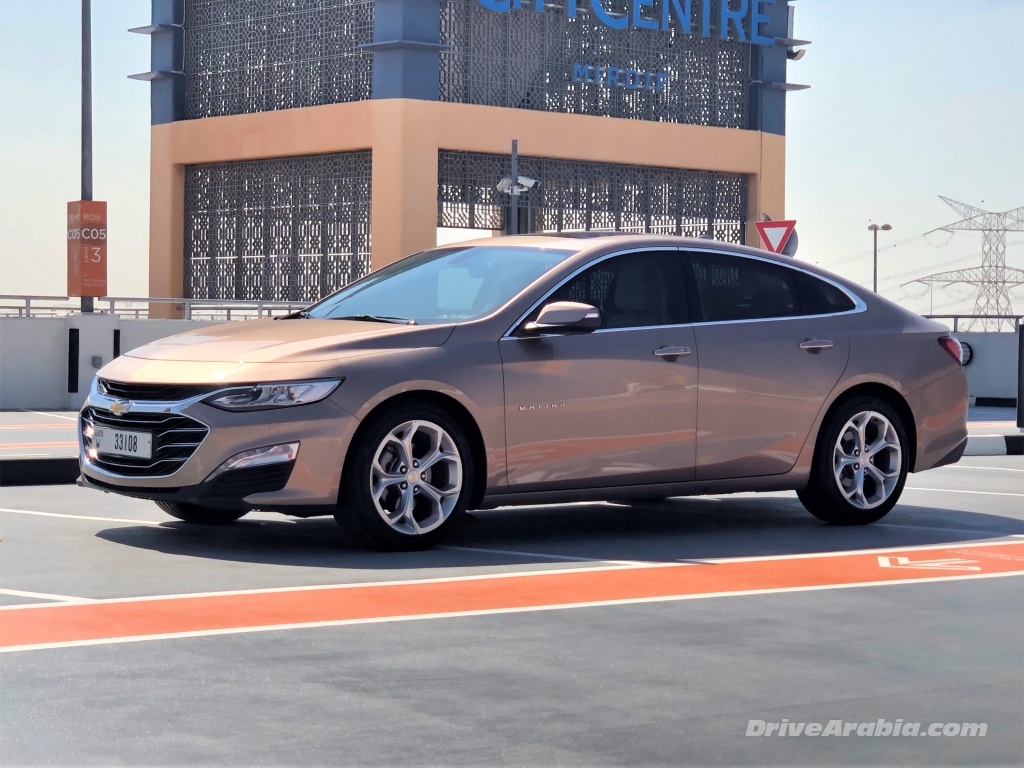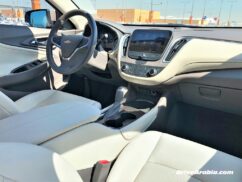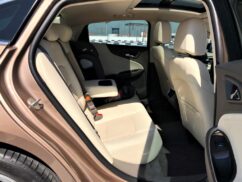2020 Chevrolet Malibu 1.5T Premier
| The Good: – Sharply styled inside and out – Quiet ride and good handling – Efficient and strong engine |
The Bad: – Slightly less rear legroom than rivals – Few hard-plastic cabin bits – Some infotainment hiccups |
The midsize sedan segment is a competitive one dominated by the Japanese. But Chevrolet has had a competent entry for a few years now that hasn’t gained traction, even with competitive pricing. The current Malibu garnered a decent review from us when it was launched in late 2016, but then the well-known Japanese trio all got redesigns as well, raising the bar for what a midsize sedan can offer. The Korean-built Malibu received a quiet facelift for 2019 though, along with a new engine that’s a huge improvement.
The facelift consists of a redesigned front bumper, redone tail lights and new wheels. It still looks aggressive, if a bit overdone now with chrome trimmings. Overall, it’s still a good-looking sedan with the optional 18-inch alloys, LED running lights and tail lamps, and a swoopy “coupe-like” profile. We’re driving the top-spec Premier version of the base-engined 1.5T model.

Inside, the cabin design is pretty much unchanged, sharply styled with lots of creases and curves. There are sturdy hard plastics on the dash and upper doors, interspersed with stitched-leatherette padding on the dash face, door inserts and centre-console sides, with hard plastics below. The fake wood trim looks fake, the buttons on the steering wheel are made of rubber, and the leather is not the best quality, but then again, the car costs a bit less than many of its rivals.
In terms of space, the headroom and legroom are very good, although rear space is a bit less than the top players in this segment. However, you do get a huge boot. The split rear seats can be flipped down using latches in the boot itself, to increase cargo room. And being an American brand, there’s no shortage of cup-holders and bottle pockets.
The infotainment system has a decently-responsive 8-inch capacitive screen, easy enough to figure out how to use, although some icons are too small. Navigation and Apple Carplay are also available. We couldn’t connect our iPhone to the Bluetooth due to some error, although it has worked in other American-built Chevys.
Other notable features on this well-specced model include a decent stereo (6-speaker is standard, or a 9-speaker Bose system is optional), cooled power-adjustable front seats, smart key with remote start, panoramic glass roof, rear camera with sensors, and a very good dual-zone a/c with rear vents, aside from the usual cruise control and power accessories. Further features such as LED headlights are reserved for the 2.0T models. Safety features include four airbags (curtain airbags are reserved for the 2.0T models), ESP, ABS, tyre-pressure monitor and hill-start assist. Active safety features such as pedestrian detection, lane-keeping assist and collision mitigation are again reserved for the 2.0T models.

The new base engine replacing the old 186 hp 2.5-litre is a turbocharged 1.5-litre making 163 hp at 5700 rpm, and mated to a 6-speed automatic. Despite the reduction in power, the torque figure of 250 Nm is the same as before, except it peaks at a much lower rpm of 2500 rpm. What this means is the car actually feels quicker in daily-driving situations, even if our as-tested 0-100 kph time of 9 seconds doesn’t seem like much. The low-pressure turbo engine feels almost like a non-turbo motor once you get past the little bit of initial turbo lag, delivering power linearly, fairly responsive to inputs and offering good low-end kick as well as adequate passing power.
The 6-speed gearbox has tall ratios and shifts smoothly, clearly made with fuel economy in mind. It managed about 10.6 litres/100 km (9.4 km/litres) in our mixed driving, although it can probably do better with a lighter foot. Interestingly, the same car is offered with a CVT in the U.S. market, but while the 6-speed auto may seem outdated, we actually prefer the latter.
The steering offers almost no feedback, but it’s responsive and reasonably weighted, even if on the light side. The brakes work well, and offer linear response. Overall, the car is simply easy to drive without having to adjust to odd behaviour like those found in European or Chinese cars.
The car itself handles very nicely as well, with good grip from the 245/45 tyres and linear understeer at the limit (although note that lower-spec models get skinnier tyres). The soft suspension can be felt, but it settles down instantly after bumps and corners, with no serious body roll. Dare we say it, the Malibu is actually somewhat fun to drive, which is an unquantifiable character trait that’s painfully missing from Korean rivals that otherwise appear to offer amazing value on paper.
The impressively-comfortable ride is very quiet except for some ambient noise. Road noise starts to become noticeable above 100 kph, but it’s no more than the class average.
The newly-turbocharged 2020 Chevy Malibu is a very appealing car, and worthy of your consideration. But with General Motors announcing that they’ll start culling their sedan line-up in the United States, it is unclear if the Malibu will get a new generation. It certainly looks like the Malibu is getting better and better with every iteration.
| Price Range: Dh 79,000-107,000 Current Model Introduced in: Body Styles: Engines: Transmissions: Setup: Suspension: |
Brakes: Front: discs Rear: discs Curb Weight: Length: Wheelbase: Top Speed: Test Acceleration 0-100 kph: Observed Test Fuel Economy: |
















There are no comments. Be the first!